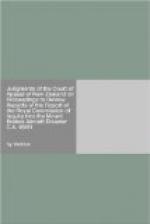In the course of his evidence (at p. 272) Mr. Chippindale was asked by the Commissioner: “Was not the position Capt. Collins must have clearly have thought he was flying toward McMurdo over McMurdo Sound?” He said, “It is my belief that this could be the only possible reason for him to continue”. That is an important answer. It means that in this respect Mr. Chippindale had reached the same conclusion as the Commissioner but for general reasons of logic whereas the latter was influenced by his finding that Captain Collins had made use of the New Zealand Atlas or a chart in order to plot the position of the waypoint and the route to be taken by the aircraft.
But although this general conclusion about McMurdo Sound was shared it is at this point that the two investigations diverged in terms of pilot responsibility for the accident. The Commissioner was of the opinion that until the last moment the pilots believed they were flying in clear air; that they were deceived by a whiteout situation; and that it was understandable that they flew on at 2000 and then 1500 feet. Mr. Chippindale was aware of and spoke in his report about the whiteout phenomenon, but after giving evidence before the Royal Commission for eight days he still adhered to his conclusion of pilot error for reasons he expressed (at p. 274) in the following way:
“I believe that the cause as it stands (in the Chief Inspector’s report) is reasonable. As I attempted to clarify last time the pilot has descended to 2000 ft and evidently is unable to see anything ahead. I say ‘evidently’ because there is a snow slope leading to a mountain rising to 12 450 feet and that was directly in front of him. He ‘popped down’, to use his own words, another 500 feet and continued to progress towards an ice cliff which is 300 feet high, the lower 50 per cent of which is solid and bare rock. And still he didn’t perceive anything to persuade him to divert from his track. To me this indicates it was an area of poor definition and as such he would not be able to discern what he could expect to see had he been, as various people suppose, believing that he was proceeding down the McMurdo Sound. The sea ice is by no means uniform in texture and during his descent he would have seen the nature of the sea ice—in fact the photos from the passengers indicate that it had large breaks in its surface and was quite easily discerned so therefore I believe at the end of his descent to 2000 ft he was confronted with a very vague area in front of him which he may or may not have believed was cloud, and when descending a further 500 feet the view ahead of him would have been of equally poor definition. Despite this, he continued to the point of 26 miles from destination as indicated presumably on the AINS.”
Mr. Chippindale’s opinion has some background relevance in the present case. It is in no way relevant because it differs from that of the Commissioner upon the issue of causation. Already we have emphasized




